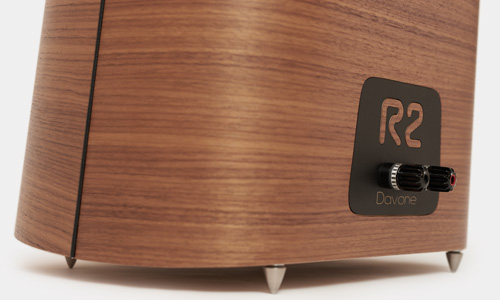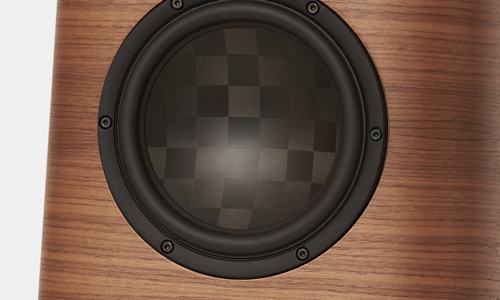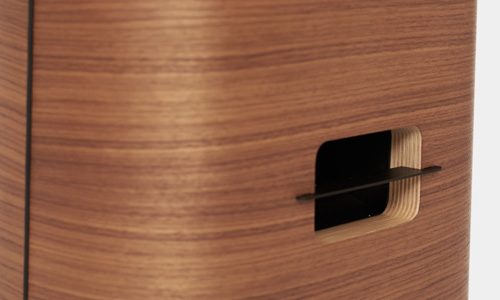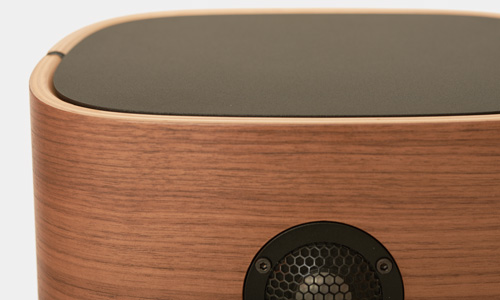-
Frequency response
38 - 30.000 Hz, -3dB
Impedance
4.5 ohm minimum
Sensitivity
87 dB/2,83V/m
Recommended Amplifer
100 watt or more
Woofer
7,5" Multimodal Textreme membrane with distributed low energy breakup modes
-
Tweeter
Flush mount 1" Beryllium with extremely light 0.1g dome and a first breakup mode above 40kHz
System
bass reflex with a linear port
Cabinet Construction
25mm form pressed plywood with acoustic reflectors, low loss bracing and tuned absorber
Weight
21 kg / piece
Height / Width / Depth
97 / 34 / 31 cm
Designer
Paul Schenkel

Davone Reference Two
With its roots in the Reference One, the Reference Two is of similar no compromise acoustic design. Despite its more compact design, the sound similarities are uncanny, a testament to the design quality. The best way to describe the R2 is revealing yet easygoing, with a very well-controlled bass. Once you start listening, you’re hooked.


-

-
More than Beryllium
Due to its incredible rigidity, Beryllium represents the ultimate material for a tweeter dome. Where soft domes turn choirs into grain, hard rock into noise, Beryllium can separate the complex harmonics with ease and keep the music clean and precise, also at high listening levels. But we do not stop there. Opting for an unconventional approach, we mount the dome flush with the baffle, as opposed to the typical recessed placement, allowing the dome to unleash its wide off-axis response without obstruction—vital for achieving an expansive, open sound. This unique dome placement is a rarity, demanding meticulous baffle rounding to prevent diffraction and a more intricate crossover design. However, the resulting benefits outweigh the challenges. Complementing this design, we employ an exceptionally narrow surround to eliminate any lingering "soft dome" coloration. With a mere 0.1-gram moving mass and a magnetic flux density of 2.0 Tesla, our high frequencies reach reference-level quality.
-
A Metamodal Membrane
A what?? Let me explain. The Swedish company Oxeon invented a unique process to produce a very flat uni-directonal fiber tape. A weave made with this tape can be very flat and therefore requires less resin and weighs less compared to a traditional fiber weave. In other words, more carbon fibers can be used for the same weight. In fact, Textreme as it is called, is so stiff that the familiar edge resonance around 1-2 kHz is eliminated. This stiffness usually comes at the cost of severe resonances at higher frequencies which limits the operating range. But by optimising the thickness and stiffness, the Textreme membrane is engineered for a controlled resonant behaviour by distributing the break up modes, a metamodal membrane. These distributed modes, or resonances, are far less severe and the useable frequency range is increased. It is the perfect membrane for a wide range loudspeaker. The sound it produces is entirely free from resonance, delivering an exceptional combination of purity, neutrality, and speed.
-

the Colour of Sound
String instruments produce a fundamental tone and a vast array of higher harmonics, demonstrating the human ear's preference for a rich, harmonic sound. Record players and tube amplifiers also introduce harmonics, creating a vibrant and colorful sonic experience, akin to the significant impact of optimal room acoustics. Many loudspeakers also contribute their own tonal character, for example aluminum tweeters often deliver a remarkably open, clear, and transparent sound. However, this pleasing tonal coloring can sometimes overshadow and actually result in timbral deficiency, concealing subtle tones. The Reference One's Beryllium tweeter, on the other hand, offers a gentler percussion representation, excelling in tone separation and micro-detail reproduction, effectively distinguishing musical instruments in spatial placement. Similarly, the Textreme Carbon midrange exhibits a smooth and well-balanced timbre, unveiling intricate sound micro-textures without introducing any coloration. Consequently, while drivers crafted from simpler materials like aluminum or paper may sound appealing with straightforward music such as classical guitar or solo vocals, the Beryllium and Textreme Carbon drivers transcend these constraints. The Reference One faithfully unveils the full tonal spectrum of even the most intricate musical compositions.
-
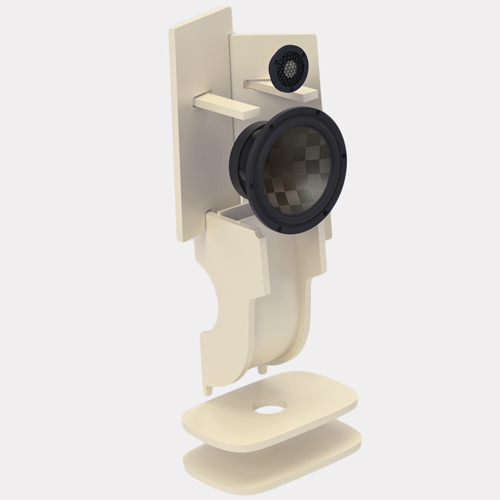
-
Asymmetric Design
A woofer in a two-way system has to reproduce both middle and low frequencies. This typically leads to unwanted cabinet resonances. Adding damping material would among other reduce low-frequency output, unacceptable in the no-compromise design of the Reference Two. Instead, as a result of a thorough investigation, an asymmetric acoustic design is employed. Inspiration came from the woofer membrane. The slight asymmetry in the chessboard pattern in the membrane helps to distribute the resonances and they become far less severe. A similar approach is used inside the cabinet. Two angled, asymmetrically placed wave reflectors spread the cabinet resonances in the mid range and reduce their amplitude, eliminating the need for damping materials. The low frequency resonance is damped with a highly effective Helmholtz absorber, again limiting the amount of damping. Internal bracing is designed for maximum free airflow to prevent low frequency losses and the bass port entry is located close to the woofer. All these measures collectively result in an effective low-frequency design with minimal unwanted resonances throughout the operating range of the woofer.
The Finishing Touch
A loudspeaker of such exceptional caliber requires a superior finish that mirrors its exceptional sound quality. We've meticulously chosen materials to elevate your audio experience, including exquisite quarter-cut walnut veneer, an elegant grille to conceal the bass reflex port outlet, discreetly positioned Davone spikes, and an all-encompassing, meticulous finish. Each material was selected for its practicality and durability, ensuring that you can savor the highest audio quality for years to come.
